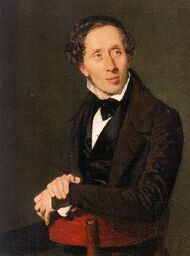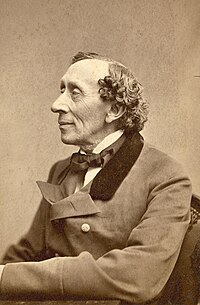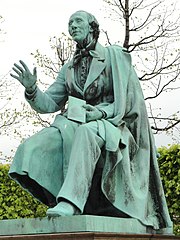(→External links: Linking to Danish Wikisource and Wikiquote the neat way.) Tag: sourceedit |
(Wikivoyage.) Tag: Source edit |
||
| (8 intermediate revisions by 2 users not shown) | |||
| Line 1: | Line 1: | ||
[[File:HansAndersen1836.jpg|right|thumb|190px|1836 portrait of Hans Christian Andersen by Christian Albrecht Jensen.]] |
[[File:HansAndersen1836.jpg|right|thumb|190px|1836 portrait of Hans Christian Andersen by Christian Albrecht Jensen.]] |
||
| − | '''Hans Christian Andersen''' (April 2, 1805 - August 4, 1875) was a Danish [[author]]. His works included [[poetry]], plays, [[novel]]s and [[non-fiction]] accounts of his travels to various European countries but he is best known today for the [[Short story|short stories]] which he wrote for children. Andersen's [[Andersen's Fairy Tales|fairy tales]], which often feature [[fantasy]] elements, such as [[character]]s which are talking animals or even inanimate objects, would go on to greatly influence later children's writers, such as Beatrix Potter, [[Kenneth Grahame]] and [[A.A. Milne]]. His children's stories have been adapted as plays, operas, ballets, animated cartoons and live-action movies. The figure of Andersen the storyteller has itself become a feature of modern popular legend. |
+ | '''Hans Christian Andersen''' (April 2, 1805 - August 4, 1875) was a Danish [[author]]. His works included [[poetry]], plays, [[novel]]s and [[non-fiction]] accounts of his travels to various European countries but he is best known today for the [[Short story|short stories]] which he wrote for children. Andersen's [[Andersen's Fairy Tales|fairy tales]], which often feature [[fantasy]] elements, such as [[character]]s which are talking animals or even inanimate objects, would go on to greatly influence later children's writers, such as [[Beatrix Potter]], [[Kenneth Grahame]] and [[A.A. Milne]]. His children's stories have been adapted as plays, operas, ballets, animated cartoons and live-action movies. The figure of Andersen the storyteller has itself become a feature of modern popular legend. |
==Biography== |
==Biography== |
||
| Line 19: | Line 19: | ||
[[File:Hans Christian Andersen statue in Kongens Have - Copenhagen - DSC07861.JPG|right|thumb|180px|Statue of Hans Christian Andersen by August Saabye in Rosenberg Castle Gardens, Copenhagen.]] |
[[File:Hans Christian Andersen statue in Kongens Have - Copenhagen - DSC07861.JPG|right|thumb|180px|Statue of Hans Christian Andersen by August Saabye in Rosenberg Castle Gardens, Copenhagen.]] |
||
| − | Andersen also visited Spain, Portugal and Sweden and wrote accounts of his travels there. He was a supporter of greater cooperation between Denmark, Sweden and Norway and believed in a common Scandinavian identity. His 1839 poem ''Jeg er en Skandinav'' ("I am a Scandinavian") was set to music by the Swedish composer Otto Lindblad in 1840 and served as an unofficial Scandinavian national anthem of sorts until 1845. |
+ | Andersen also visited Germany, France, Spain, Portugal and Sweden and wrote accounts of his travels there. He was a supporter of greater cooperation between Denmark, Sweden and Norway and believed in a common Scandinavian identity. His 1839 poem ''Jeg er en Skandinav'' ("I am a Scandinavian") was set to music by the Swedish composer Otto Lindblad in 1840 and served as an unofficial Scandinavian national anthem of sorts until 1845. |
Hans Christian Andersen never married or had children. Unrequited love would be a persistant theme throughout his life. His letters and diaries indicate that he fell madly in love with a number of people, both men and women, but none of them returned his affections and, consequently, he did not have a real romantic relationship with any of them. Andersen proposed to the Swedish opera singer Jenny Lind by handing her a note as she was boarding a train. Although Lind was fond of Andersen, she does not appear to have seen him as a potential husband. In an 1844 letter, she calls him "my brother". |
Hans Christian Andersen never married or had children. Unrequited love would be a persistant theme throughout his life. His letters and diaries indicate that he fell madly in love with a number of people, both men and women, but none of them returned his affections and, consequently, he did not have a real romantic relationship with any of them. Andersen proposed to the Swedish opera singer Jenny Lind by handing her a note as she was boarding a train. Although Lind was fond of Andersen, she does not appear to have seen him as a potential husband. In an 1844 letter, she calls him "my brother". |
||
| Line 25: | Line 25: | ||
In 1872, Andersen badly injured himself when he fell out of bed. He never fully recovered from his injuries and died three years later. Shortly before he died, Andersen spoke to a composer regarding suitable music to play at his funeral. Knowing that many of those who followed his funeral procession would be children, he wanted the music to be something with which children would not have difficulty keeping in step. |
In 1872, Andersen badly injured himself when he fell out of bed. He never fully recovered from his injuries and died three years later. Shortly before he died, Andersen spoke to a composer regarding suitable music to play at his funeral. Knowing that many of those who followed his funeral procession would be children, he wanted the music to be something with which children would not have difficulty keeping in step. |
||
| − | Before Andersen's death, plans were already underway to honor him by putting up a large statue of him in Copenhagen. The statue by August Saabye is now on display in the city's |
+ | Before Andersen's death, plans were already underway to honor him by putting up a large statue of him in Copenhagen. The statue by August Saabye is now on display in the city's Rosenborg Castle Gardens. |
| + | |||
| + | ==See also== |
||
| + | *[[Brothers Grimm]] |
||
| + | *[[Charles Perrault]] |
||
==External links== |
==External links== |
||
*Works of Hans Christian Andersen in [[wikisource:da:Forfatter:Hans Christian Andersen|Danish]] and [[wikisource:Author:Hans Christian Andersen|English]] on Wikisource. |
*Works of Hans Christian Andersen in [[wikisource:da:Forfatter:Hans Christian Andersen|Danish]] and [[wikisource:Author:Hans Christian Andersen|English]] on Wikisource. |
||
*Quotations by and about Hans Christian Andersen in [[wikiquote:da:H.C. Andersen|Danish]] and [[wikiquote:Hans Christian Andersen|English]] on Wikiquote. |
*Quotations by and about Hans Christian Andersen in [[wikiquote:da:H.C. Andersen|Danish]] and [[wikiquote:Hans Christian Andersen|English]] on Wikiquote. |
||
| + | *[[wikivoyage:Travels of Hans Christian Andersen|Travels of Hans Christian Andersen pn Wikivoyage.]] |
||
*[http://www.andersen.sdu.dk/index_e.html Hans Christian Andersen Center of the University of Southern Denmark.] |
*[http://www.andersen.sdu.dk/index_e.html Hans Christian Andersen Center of the University of Southern Denmark.] |
||
*[https://librivox.org/author/122 Free public domain audiobooks of Hans Christian Andersen's works from LibriVox.] |
*[https://librivox.org/author/122 Free public domain audiobooks of Hans Christian Andersen's works from LibriVox.] |
||
| + | *[http://museum.odense.dk/en The Hans Christian Andersen Museum, Odense, Denmark.] |
||
{{DEFAULTSORT:Andersen, Hans Christian}} |
{{DEFAULTSORT:Andersen, Hans Christian}} |
||
| + | [[es:Hans Christian Andersen]] |
||
| − | |||
| + | [[fr:Hans Christian Andersen]] |
||
[[pl:Hans Christian Andersen]] |
[[pl:Hans Christian Andersen]] |
||
[[Category:Poets]] |
[[Category:Poets]] |
||
Revision as of 13:41, 15 November 2020

1836 portrait of Hans Christian Andersen by Christian Albrecht Jensen.
Hans Christian Andersen (April 2, 1805 - August 4, 1875) was a Danish author. His works included poetry, plays, novels and non-fiction accounts of his travels to various European countries but he is best known today for the short stories which he wrote for children. Andersen's fairy tales, which often feature fantasy elements, such as characters which are talking animals or even inanimate objects, would go on to greatly influence later children's writers, such as Beatrix Potter, Kenneth Grahame and A.A. Milne. His children's stories have been adapted as plays, operas, ballets, animated cartoons and live-action movies. The figure of Andersen the storyteller has itself become a feature of modern popular legend.
Biography
Born in the Danish tow of Odense, Hans Christian Andersen was the only child of Hans Andersen and Anne Marie Andersdatter. His mother, a washerwoman, had no formal education at all and his father's education was extremely limited. It was Andersen's father, however, who first introduced him to literature by reading him stories from The Thousand and One Nights. There was a family legend that the Andersens were of aristocratic origin, although there appears to be no truth in this. The persistent rumor that Hans Christian Andersen was the illegitimate son of King Christian VII of Denmark also appears to be completely unfounded. Andersen's father died in 1816 and his mother remarried two years later.
Andersen attended a local school for poor children and supported himself by working first as a weaver'a apprentice and later for a tailor. At the age of 18, Hans Christian Andersen moved to the Danish capital Copenhagen, hoping to become an actor. Thanks to his excellent soprano voice, Andersen got a position at the Royal Danish Theater. When his voice suddenly changed, he began to focus on writing instead.
A wealthy benefactor, Jonas Collin, paid for Andersen to continue his education. He attended various schools around Denmark until 1829. Andersen would later say that it was an unhappy period in his life, during which he was abused and discouraged from writing.
"The Ghost at Palnatoke's Grave", Andersen's first published short story, appeared in print in 1822. An early fairy tale by Andersen, "The Tallow Candle", was written while he was attending school in the 1820s but remained unpublished and undiscovered until October 2012.

1869 photograph of Hans Christian Andersen by Thora Hallager.
In 1829, Andersen achieved some success with a short story, "A Journey on Foot from Holman's Canal to the East Point of Amager", a play, Love on St. Nicholas Church Tower and a short book of poems. In 1833, he received a travel grant which allowed him to visit Switzerland and Italy. Andersen drew on his travel experiences in his first novel The Improvisatore, published in 1835.
Andersen's first collection of fairy tales, which was made up of the four stories "The Princess and the Pea", "The Tinderbox", "Little Claus and Big Claus" and "Little Ida's Flowers", was published as an inexpensive booklet without a cover in 1835. An expanded version of nine stories, which became the first volume of Andersen's Fairy Tales Told to Children and also included "Thumbelina", "The Little Mermaid" and "The Emperor's New Clothes", was published in 1837. The stories were not initially well received in Denmark and the book sold poorly. However, a second volume of Fairy Tales Told to Children, which was made up of "The Daisy", "The Steadfast Tin Soldier" and "The Wild Swans", was published in 1838. Andersen's reputation received a tremendous boost after his fairy tales began to be translated into other languages, the first English translations of some of his children's stories appeared in 1845. Andersen's works in translation received very good reviews, and he soon became celebrated throughout Europe. Andersen continued writing fairy tales until 1872.
In 1847, Andersen visited Britain and was introduced to Charles Dickens. Andersen wrote in his diary, "I was so happy to see and speak to England's now living writer whom I love the most". Dickens also admired Andersen and the two men wrote to each other for ten years. Andersen stayed at Dickens' home for five weeks in 1857. Charles Dickens' family were very unhappy that Andresen chose to stay with them for so long and Dickens ceased all communication with him afterwards.

Statue of Hans Christian Andersen by August Saabye in Rosenberg Castle Gardens, Copenhagen.
Andersen also visited Germany, France, Spain, Portugal and Sweden and wrote accounts of his travels there. He was a supporter of greater cooperation between Denmark, Sweden and Norway and believed in a common Scandinavian identity. His 1839 poem Jeg er en Skandinav ("I am a Scandinavian") was set to music by the Swedish composer Otto Lindblad in 1840 and served as an unofficial Scandinavian national anthem of sorts until 1845.
Hans Christian Andersen never married or had children. Unrequited love would be a persistant theme throughout his life. His letters and diaries indicate that he fell madly in love with a number of people, both men and women, but none of them returned his affections and, consequently, he did not have a real romantic relationship with any of them. Andersen proposed to the Swedish opera singer Jenny Lind by handing her a note as she was boarding a train. Although Lind was fond of Andersen, she does not appear to have seen him as a potential husband. In an 1844 letter, she calls him "my brother".
In 1872, Andersen badly injured himself when he fell out of bed. He never fully recovered from his injuries and died three years later. Shortly before he died, Andersen spoke to a composer regarding suitable music to play at his funeral. Knowing that many of those who followed his funeral procession would be children, he wanted the music to be something with which children would not have difficulty keeping in step.
Before Andersen's death, plans were already underway to honor him by putting up a large statue of him in Copenhagen. The statue by August Saabye is now on display in the city's Rosenborg Castle Gardens.
See also
External links
- Works of Hans Christian Andersen in Danish and English on Wikisource.
- Quotations by and about Hans Christian Andersen in Danish and English on Wikiquote.
- Travels of Hans Christian Andersen pn Wikivoyage.
- Hans Christian Andersen Center of the University of Southern Denmark.
- Free public domain audiobooks of Hans Christian Andersen's works from LibriVox.
- The Hans Christian Andersen Museum, Odense, Denmark.
